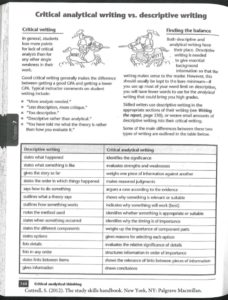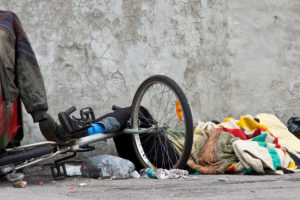In addition to using topic and concluding sentences to improve your writing, another effective means to strengthen your argumentation is to pay attention to your use of descriptive vs critical writing. Both forms of writing are important, but when we receive reviews that we need to balance when we are merely reporting the facts (descriptive) and when we are weighing on and making a claim about those facts (critical). The handout that I share with my graduate students is a one-page excerpt from a study skills handout that came across my path as I began my academic career (Cottrell, 2012, p. 160).

The author provides a side-by-side comparison between descriptive vs critical writing. Let’s take the first example: “states what happened” vs “identifies the significance”. Now let’s try and come up with an example. I might write “Brown (2005) used the term ‘schoolscapes’ to describe the linguistic landscapes of schools”. That sentence is descriptive and states when happened. To make it more critical, I might edit it to read “Brown (2005) was the first to use the term ‘schoolscapes’, which is recognized as the official term to describe the linguistic landscapes of schools.” With these edits, the reader now has a clearer sense of how important Brown (2005)’s use of the term was. Inherent in any claim is the chance that one might be incorrect. Brown may have written the term in an earlier work or she may not have been the first to use the term, but I have identified the significance and part of the strength of my argument comes from the ability of someone to challenge this claim. Entering into scholarly debate is part of the reason with engage in scholarly writing, so we need to be prepared to stand behind our argumentation.
Let’s try another: In an article about German Bilingual Program teachers (Dressler & Mueller, 2022), we might have originally crafted a sentence like this: “In bilingual programs, teachers are often not aware of the pedagogical strategies from other programs such as French immersion and rely heavily upon professional learning to develop their repertoire”. This might be considered as “states links between items” since we state that teachers are not aware of pedagogical strategies and therefore rely upon professional learning. However, since we wanted to “show the relevance of links between pieces of information”, we added the reasons why teachers are not aware of pedagogical strategies:
“In bilingual programs, no one teaching approach is mandated, and since many teachers are not second language specialists (Dressler, 2018; Zhang & Guo, 2017), they are often not aware of the pedagogical strategies from other programs such as French immersion and rely heavily upon professional learning to develop their repertoire”. In doing so, we were also able to cite literature to back up those reasons so that the reader is aware that these are documented reasons that teachers end up relying so heavily upon professional learning. The ability to draw upon previous studies to support our work strengthens our claims as grounded rather than mere opinions.
As a final example, I am providing a whole paragraph from Dressler et al, (2023, p. 234) which demonstrates how descriptive and critical writing can complement one another. This paragraph goes from “notes methods used” to “identifies when something is appropriate or suitable”.
The chart required only affirmative answers. Therefore, if part or all of the chart was skipped, it could not be determined whether the participants did so because they did not use technology or because they did not wish to answer the question. To avoid drawing conclusions about participants who did not indicate any technology usage at any time period in the chart, we removed those participants (n = 63) who did not provide any answers to that survey question. As a result, the data from the remaining 203 participants were analyzed.
The first two sentences are descriptive. The third sentence is critical, letting the reader know it would not have been suitable to assume blank answers meant “no, I didn’t use technology” since it could also have meant “I don’t feel like answering all of the questions in this survey”. The final sentence goes back to noting the result of that critical consideration, but is in itself descriptive.
The handout is so simple, yet it makes such a difference in one’s writing when the concept of descriptive vs critical writing is taken into account. The choice of which task you wish your writing to complete is up to your discretion as the writer. I encourage you to print out this handout and use it regularly and leave a comment below it if you have found it helps your writing.
The page I am referencing can be found here:
Cottrell, S. (2012). The study skills handbook. Palgrave Macmillan.
Examples for this blog came from one yet-to-be published piece as well as the two below:
Dressler, R., Guida, R., Chu, M-W. (2023). Canadian second language teachers’ technology use following the COVID-19 pandemic. Canadian Modern Language Review, 79(3), 228-246. https://doi.org/10.3138/cmlr-2022-0069
Dressler, R. & Mueller, K. (2022). Pedagogical strategies to foster target language use: A nexus analysis. Canadian Modern Language Review, 77(4), 75-90. https://doi.org/10.3138/cmlr-2020-0084

















